|
|
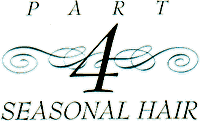
like to think that any given hairstyle has its seasons and can and should be adapted to changing weather and mood. (Hair also has its special care needs in each season--whether it is subjected to sun or the biting wind, to the stickiness of high humidity or the crackle of winter dryness.)
Changing your hair from season to season may be done through cutting, altering the texture (the body or curl), lifting or subduing the color slightly, or dressing it in a special way. A nod to the change of seasons can also be made through the things you use on your hair to clean, condition, and nourish it...especially where scent--a sort of portable aromatherapy-is concerned: who doesn't have vivid memories of hair that smells delicately floral and fresh on the first days of spring? Of summer hair that recalls the sweet heat and cool aroma of an herb garden? Or the warmth and muskiness of hair on the first cold days? Or the excitement and tingle of spice on hair in the winter cold? Why not extend the pleasure in your crowning glory to all your senses? Recipes in this chapter, therefore, are especially important for their "aromatherapeutic" value.
I am going to begin with summer because I think this season is hardest on hair...or rather, we allow things to happen to our hair in summer that are especially hard on it. We subject it to salt water and chlorine (which can turn color-treated hair green); we sit in the sun and burn it (hair burns just the way your skin does); and because too many of us love that sun-streaked look, we insult our hair further by putting harsh stuff on it to strip it and make it blonder...and then sit in the sun again to damage and fade it even more. When I think of summer, I think protect, protect, protect. Skin, scalp, hair: all need special protection from the ravages of the outdoor life. And what is past protection needs special attention.
The best all-around protection for your hair (as well as your skin) is to shade it by wearing a hat or staying out of the sun altogether. This is unrealistic for most of us, however, with our very active lives, so the next best solution is to coat the hair strands--and protect the scalp--with some substance that will give your hair a fighting chance. And the best substance I know of is a mixture of a good sunscreen and a cream rinse or conditioner. Mix, work into your hair, and then comb through with a wide-toothed comb for even distribution. Slick back your hair. (Who likes hair hanging in her face in the sun?) This looks sleek, pretty, and summery and gives your hair a sort of hot-pak as you sun. Don't forget to reapply every hour or so to refresh the mixture's effectiveness, and be sure to give yourself a generous reanointment after a swim. When you wash your hair after sunning, don't use any more conditioner. What remains in your hair will be quite enough to take care of your conditioning needs.
If you like the idea of making your own conditioner and don't feel you need that extra sunscreen protection, here are two slickers that you can make for sunning and swimming. Wash them both out thoroughly after sunning.
The easiest lift for that streaked effect people like so much is very old-fashioned, and if your hair is not fragile--better yet, if it is a little oily--you can use a lemon juice rinse to tone your scalp, get rid of excess oil, and restore natural highlights to naturally blond or light-brown hair (this is not a good idea if your hair has been permed or color-treated):
For some people, this kind of natural lightener works wonderfully well; the result is hair that looks like it belongs to kids who live outdoors. The older one gets, however, and the more one's hair has been through, the less likely it is that this method will be successful: your hair can end up looking faded and haystack-y instead of becomingly streaked. And please, please, don't use peroxide--in the sun or out. You will get brassy orange instead of blond. To counteract the fading effects of the sun and play up the highlights and color your hair already has as well as its shine, try these natural rinse/conditioners:
Another way to protect hair that is not color-treated from sun, salt water, and wind, while intensifying color and adding vibrancy and sparkle, is to use henna, which is a natural vegetable compound that protects the hair shaft while adding depth to its color. Henna won't give you the brassiness that too often follows overexposure of processed hair. Some think only people with red highlights in their hair can use henna. With the new henna compounds this is not true: as discussed previously, blonds will see their hair lifted half a shade, while women with darker hair will find it gives their natural color a richness and warmth. Most everyone who uses henna is rewarded with added body and sheen.
Even the best-laid plans for hair protection can go awry...just as the occasional sunburn is probably inevitable. If you've had too much sun, here is a wonderfully soothing remedy for sunburned hair and scalp:
To restore lost shine to sunburned hair, use "Gleam Rinse." Here's the recipe again:
Summer is a great time to have fun with all those casual styles you wouldn't think of wearing during the rest of the year, except perhaps for active sport: braids and twists, corn rows, ponytails. The wonderful thing about these summer variations is that they can be adapted to all but the shortest hair. When you learn how to handle your hair, you can do almost anything with these "unmessers," even try combinations of them (braids and ponytails, for instance). You can also make these very practical styles work for you for evening or for daytime sophistication, with variations on the chignon. Another possibility is to use combinations of braiding and twisting to achieve a very sophisticated look (if you keep your hair up and back and relatively severe).
Braiding (or plaiting, as we say in England) is a style that is as old as civilization. It is obviously easier to braid longer hair, but short hair can be partly corn-rowed and partly braided to achieve what amounts to a braided effect. Basically, braiding is the weaving of strands of hair together in a pattern. Hair can be flat-braided (the three-strand braid) or round-braided (the lanyard braid of four strands, which is harder to do but worth the effort because its 3-D effect is so You can also achieve a wonderful look by braiding your hair when it is damp (or just leave the braids you already have in place after swimming) and then letting it dry completely in the braid. When your hair has dried, either undo the bottoms of the braid and let your hair unravel naturally, or unbraid it completely and luxuriate in the Pre-Raphaelite, romantic look the ripples will give you.
Hair that is damp and has at least some wave is easiest to braid; it curves better into the twists and weaves you are making. (People with straight hair often realize that if their hair is not damp when braided-and even sometimes when it is--little "sticks" and spikes of hair are forever popping out and make the braid look porcupine-y.) Gels or mousses can help with this smoothing if your hair tends to stick out of a braid. Just comb the gel or mousse through your damp hair (don't use too much--allow it to be diluted by the wetness of your hair) and then braid before it dries, smoothing those little stray pieces back in carefully. Once you've finished, hold the braid in with covered elastics (you can find these in the dime store). The little ones are best for all but the thickest hair because you need to do less winding. Try to avoid regular bare rubber bands, as they catch in your hair and are likely to tear it. If you don't like the look of the elastic holder, either cover it with a strand of hair from the braid itself or wrap a short length of ribbon around it. (One or more pieces of narrow ribbon can also be braided through the hair; this is lovely and quite festive!) As pretty and convenient as braids are, people are sometimes not as careful as they might be to protect their braided hair. Remember: 1
Don't pull the braid too tight at the scalp; it can result in hair loss. 2
Avoid leaving the braids in too long: it can lead to breakage where the same area is consistently exposed.
Corn rowing is really a flat braid that is kept close to the head by picking up more hair along the scalp with each twist until the While most corn rowing--especially that done with black/Afro hair, where corn rowing originated--is done with very few strands at a time (there may be literally hundreds of attached braids that may or may not swing clear of the head, depending on how long the hair is), corn rowing can also be done with more strands of hair at a time so there are relatively few braids--perhaps only a couple (one over each ear, for instance) with the rest of the hair left unbraided. It is usually easiest to get someone else to corn row your hair for you: elaborate corn rowing is both exacting and laborious. The good news is that a skillfully done job--especially if your hair has enough natural curl to hold the braids--can last for weeks at a time; just wash your hair with the braids in. Corn rows can also be dressed up with all kinds of decorations that are slipped right onto the braid from its loose end, so that the ornaments are held tight by the braiding itself. This is great fun and sounds wonderful (all that clicking and jingling!) in the summer.
Chignons (and buns, which are a sort of homelier version of chignons) have also been around for a very long time; they are traditionally worn by older and/or more sophisticated "ladies." Recent variations on the chignon, however (like the "washer-woman" style so popular about five years ago), show how the chignon/bun/twist can be adapted to anyone's hair and life-style. 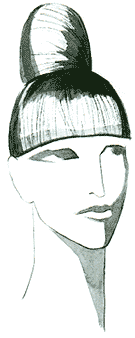 Basically the chignon effect is achieved by twisting and rolling the hair, then pinning it tight. One of the tricks to understanding how this works is to realize that if you take a hank of your hair and begin to twist, it will form itself into a bun or the more classic chignon form, a figure eight. This style is hard to fake with shorter hair, so you need to have enough length to twist the hair and have it coil itself into at least one tight circle. The knot then is held either with hairpins or one of the newer one-stick fasteners. There is even a version of the chignon that is pinless--who wants metal sticking into her head in the hot summer? 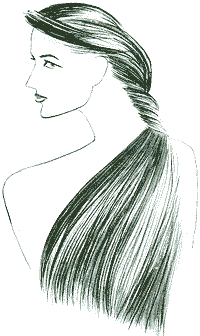 One variation that can be achieved with slightly shorter hair is what you probably know as the French twist, which is really more a method for fastening hair at the back of the head for a neat, small look. For this style, your hair only needs to be long enough to get it back (and gel or mousse can help in this); a row of hairpins holds the overlap that gives the impression of longer hair. 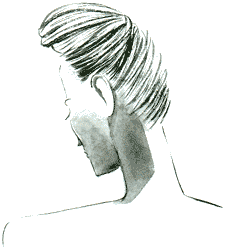 All of these twist-and-knot alternatives are perfect for summer...and any other season when you want your hair to be sleek, sophisticated, and off your face. The beauty of chignons, twists, and buns for summer is that they needn't be so literally "up tight" (try pulling some hair around the face out of the knot, letting it fall so that it frames the features: a terrific, more casual look!), and they are wonderful for anybody with longer hair because their shapes and volumes are so versatile. 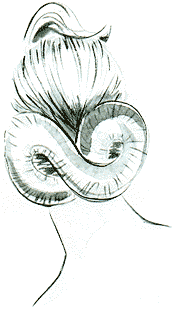
There are no two ways about it: I love flowers and herbs, and I use them however and whenever I can in and on hair. Summer is absolutely the best time to take advantage of nature's bounty...and if you don't have your own garden to grow flowers and herbs for steeping (to make floral and herbal waters and other hair remedies), the produce stand and flower market are almost as good. A dressed-up hairstyle on a summer evening looks even more dressed up with flowers. Stick one into a twist (perhaps a marigold as a spirit lifter), braid them right into your hair (daisies are hardy enough for this and will hold almost as long as your braid), or line the whole edge of a chignon with a series of tiny brilliant flowers like pansies. Tuck one behind your ear (one of those big, tropical looking beauties!) and think thoughts of exotic gardens and perfumed nights. Or--my favorite--make a classical garland (sew the flowers together with a large needle and dental floss, or use florist's wire for a less floppy version) and perch it on your shining glory. Flowers can also be slipped under combs or over barrettes, and they're delicious combined with ribbons--especially the thin satin kind.
Don't limit yourself just to flowers, either. For centuries herbs have been used as talismans and restoratives...and they provide some of that wonderful aromatherapy I am always going on about. Parsley (for cleansing and allure) is the all-green version of baby's breath; or use basil leaves and sprigs of dill together for aroma and good luck. Chamomile will play up the highlights in your hair, and, as Shakespeare had Ophelia say, "There's rosemary, that's for remembrance...." In short, anything natural tucked into your tresses will look pretty, smell nice, and bring you pleasure.
Fall seems to be the time to focus on repairing the damage we did during those last long dog days of summer when we were packing in every last ray of sun for the cold days to come. Let the first brisk day hit, and we are usually ready to leave summer behind and concentrate on pulling ourselves together again-getting organized, reassessing wardrobe and hair, being more serious...until next summer. Take a careful look at the condition of your hair and scalp when you know you are finished summering. Now is the time to make your treatment/repair decisions...perhaps with the help of a professional.
One of the most common after-summer problems is what appears to be dandruff but is in fact most often just a case of oversummered scalp. Any of the moisturizers mentioned in Chapter 5 ("Keeping Hair Shiny") can be used to restore bounce and sheen to your hair and health to your scalp, but I have a particular favorite for the fall--"Apple-Mash Conditioner." It cleans the scalp of dead cells and nourishes your poor abused hair.
Autumn is the ideal time to rethink hair coloring...or perhaps to consider it if you haven't done it before. Both skin and hair can appear faded, and the kind of summer lightening that looked bright in the sun can look brassy indoors, especially when you get the sallow look that comes from a faded tan. In my salon, we especially like warm tones for the hair in the fall. It seems just right for the mood of the season, and russets and tawny shades can bring a glow to any hair or complexion, although they work best on brown hair. This is another good time to consider using henna on your hair (which also reproteinizes). We also have developed a special coloring process: protein gels. These are nonperoxide, nonammonia colors mixed with gelatin--perfect for highlights. To give that little extra life, we often blend these colors with real fruit blueberries, strawberries, and raspberries for dark hair; avocado, mango, and papaya for lighter hair.
You will probably need a good trim after the summer, and it is often in considering this fall cut that women decide on a more drastic alteration in style. You may also have gained or lost weight during the summer or changed your "look" in some way that is going to have an impact on what you decide to do about your hair. Many women start thinking of a slightly more finished look; fall is the time (perhaps because of old associations with the beginning of another school year) when you feel just a little bit more grown up. It is also the time when you are hefting those enormous fall issues of fashion magazines and thinking about wardrobe adjustments. If you haven't had a consultation recently with your hairdresser, now is the time: it is just the lift you need for facing the winter.
The major difficulties for hair in the winter are the heat and dryness (and static electricity) that are an inevitable part of the indoor environment. That's the bad news. The good news is the holidays; they brighten everyone up and give you more opportunities to dress up-and the license to do special things with your hair--than any other time of year. Let's deal with the problems first.
Just as in the summer, you must be especially vigilant in the winter about hair damage, but this time the danger is not overexposure to the great outdoors but to the great indoors. Hair gets flyaway and dry. You brush it to make it shiny, and the ends split. The scalp dries out and itches (wool caps worn for warmth and the cycle of hot and cold don't help the condition of the scalp, either). And lots of us--especially people like me, who have curly hair--end up looking as if we've put our fingers in an electric socket. Pay close attention during the winter months to your schedule for nourishing and conditioning hair and scalp: your usual program for maintaining shiny hair will need to be stepped up. Hot-paks are especially important in the winter, too, because they hydrate hair and scalp with deep moisturizing (see the hot-pak recipe in Chapter 5). And a spritz is the best antistatic remedy--one you can use throughout the day. If you ski, give yourself a hot-oil treatment right under your hat. It works all day while you have fun (the secret is in the heating effect of the eucalyptus oil).
When you get an attack of that itchy, static-y feel, try this hair freshener. It will revive hair and scalp in cold weather.
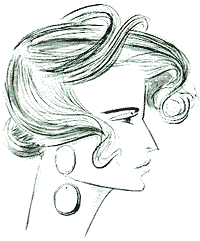 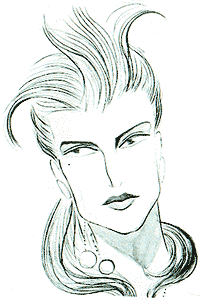 Holidays are your time to shine...and to let your creativity and fancy free. Even the simplest style can be transformed: this is when you can play with glitter in your hair or temporary color; pinecones, bells, and shiny little Christmas ornaments; garlands of tinsel or winter greens. If you never appear with curls, try cascades of them. And if you are truly adventurous, mousse your hair into fantastic shapes and decorate it with whatever you want. Everything is permissible during this festive time of year.
The weather is getting warmer. The air smells different. You feel as if you're coming alive again. It's spring. What you really want to do is wake up your hair and scalp. And I can't think of a better way to do it than with the flowers and herbs that I love.
When thoughts turn to spring cleaning and getting outside in the balmy air, it's probably time to ask yourself once again about the style you've been living with all winter. I'll bet you'd welcome a new feeling of being freed up and breezier. A perm can be fun in the spring. Your hair may be limp after a long winter of dryness and being stuck under hats. In addition, many women cut their hair less regularly during the cold months and really need an invigorating trim, whether they want the extra boost of a perm or bodywave or not. Consider a styling that is a little more adventuresome; it will lift your spirits. | ||||||||||||||||||||||||||||||||||||||||||||||||||||||||||||||||||||||||||||||||||||||||||||||||||||||||||||||||||||||||||||||||||||||||||||||||||||||||||||